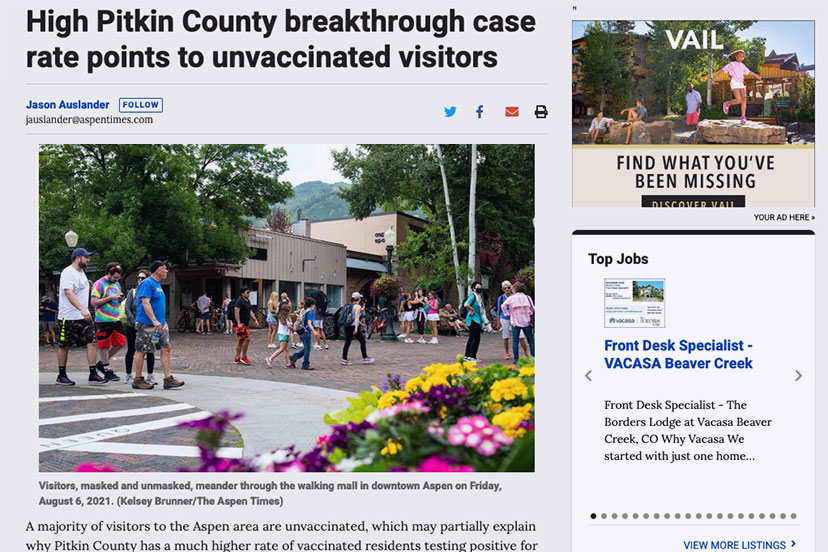The Vail Daily published a fairly typical COVID article last week. I describe article as “fairly typical” because it was constructed around pronouncements coming from public health authorities, as so much news coverage has been these past 18 months.
Typical… but strange, nevertheless.
Written by reporter Josh Auslander, it bore the headline “High Pitkin County breakthrough case rate points to unvaccinated visitors.”
Although I found the article on the Vail Daily, it had been published originally by The Aspen Times. When I viewed the article online, the web page featured two advertisements promoting tourism in Vail. One of the ads was soliciting a Front Desk Specialist for vacation rental management company Vacasa. The other ad linked to the Vail tourism website, DiscoverVail.com which makes a pitch for all the wonderful things you can do in Vail, if you are a tourist.
Mr. Auslander’s article, meanwhile, focused most of its coverage on a particular Aspen, Colorado authority who would like to blame tourists for the high percentage of ‘breakthrough infections’ among local folks who have (supposedly) been successfully vaccinated against COVID infections.
From Mr. Auslander’s article:
A majority of visitors to the Aspen area are unvaccinated, which may partially explain why Pitkin County has a much higher rate of vaccinated residents testing positive for COVID-19 than public health officials expected, an official said Thursday. In fact, 66% of all positive COVID-19 cases among residents in Pitkin County in the 28-day period ending Tuesday have been so-called “breakthrough” cases, or those involving fully vaccinated residents, Josh Vance, county epidemiologist, told members of the Pitkin County Board of Health on Thursday.
“The breakthrough rate is a lot higher than expected,” Vance said, adding that it should be around 25% of cases.
You can read the article here.
Let’s take the numbers at face value. 66% of all positive COVID-19 cases in Pitkin County, recently, involve “fully vaccinated residents”.
Epidemiologist Jack Vance wants to blame the tourists for that high breakthrough rate.
“Because so many visitors are unvaccinated, it’s creating more risk to residents,” Vance said, adding that the overall vaccination rate drops with so many unvaccinated people circulating in the community. “There’s a great likelihood of exposure.”
The article also notes that 66% of Pitkin County residents are fully vaccinated against the virus.
So we have a curious correlation here. Apparently, 66% of Pitkin County is ‘fully vaccinated’. And apparently, 66% of the new infections are among residents who are ‘fully vaccinated’.
If we were involved in public health, there are at least two possible explanations for this correlation. The most obvious explanation would seem to be, “The vaccines do not, in fact, offer long-term protection against infection.” Mr. Vance addresses that obvious reason, about halfway through the article.
Another likely important issue in the county’s high breakthrough case rate is the possible waning of efficacy of the vaccines in the face of the delta variant onslaught, he said.
Pitkin County public health officials have analyzed vaccine data from residents who later tested positive for the virus and discovered that the rate is highest among those who were first vaccinated in January. The next highest rate was among those vaccinated in February, followed by March, Vance said.
“The data suggests that individuals vaccinated early on are likely less protected than those vaccinated later,” Vance said. “That emphasizes the need for booster doses.”
There’s another possibility ‘suggested’ by the data. Most of the Coloradans who were vaccinated in January were over the age of 65, the age group most likely to become infected and hospitalized. If the vaccines were (God forbid) relatively ineffective overall, we would then see older residents being infected at a higher rate, which might make it appear that the January vaccinations was ‘wearing off’.
Coming from that perspective, the data might suggest that, in fact, the vaccine didn’t do much of anything, for anyone, in Pitkin County.
That’s one of the problems with ‘data’. You can use it to ‘suggest’ almost anything you want to ‘suggest’. And you can choose to ignore other conclusions ‘suggested’ by the data.
Your headline can “point to unvaccinated visitors”, for example. Or, your headline can point to “Strange Tales from Pitkin County, Colorado”. Take your pick.
There’s another side to this ‘infection’ story that gets less coverage in the mass media.
American society — and most of the rest of the world, too, I suppose — has long been infected with two problematic viruses: thanatophobia, the fear of dying, and a closely related virus, necrophobia, the fear of other people dying.
I myself was infected at a very young age, by both of these viruses. The symptoms have lingered. You might say, I’m a ‘Long Hauler’.
When the culture’s value system devolves into numbers and statistics… how long you will live, how much money your investment generated, how many booster shots have been administered, how many pounds you’ve gained or lost, how many ‘Likes’ your Facebook post garnered, your child’s score on a CMAS test… it’s easy to feel that the only reality that matters is ‘numerical’.
It’s easy to conclude, when only ‘numbers’ are considered to be ‘real’, that certain qualities and activities that once held meaning — sharing, helping, patience, tolerance, smiles, hugs, singing, playing, socializing — have become unimportant.
It’s easy to conclude that “how long you live” is the most important measure, simply because… well, it’s so easy to measure it.
I sensed anger, and perhaps fear, coming from several of the people who testified at the Archuleta School District board meeting last week. Anger and fear around the wearing of masks; anger and fear around government-imposed mandates and rules; anger and fear that healthful human-to-human contact would be, or has been, outlawed.
Another attitude was also clearly on display, as the audience loudly applauded and cheered each successive speaker. Affiliation. Camaraderie. Fellowship. Loyalty. And a willingness to ‘Question Authority.’


